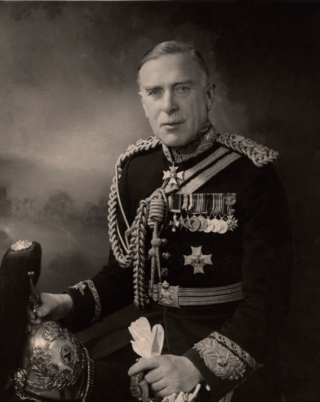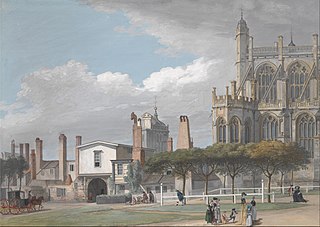
The Most Noble Order of the Garter is an order of chivalry founded by Edward III of England in 1348. The most senior order of knighthood in the British honours system, the only decorations which outrank it in precedence are the Victoria Cross and the George Cross. The Order of the Garter is dedicated to the image and arms of Saint George, England's patron saint.

Prince Arthur of Connaught was a British military officer and a grandson of Queen Victoria. He served as Governor-General of the Union of South Africa from 20 November 1920 to 21 January 1924.

The Most Honourable Order of the Bath is a British order of chivalry founded by King George I on 18 May 1725. The name derives from the elaborate medieval ceremony for appointing a knight, of which bathing was an element. Knights so created were known as "Knights of the Bath". George I constituted the Knights of the Bath a regular "Military Order". He did not revive the Order of the Bath, which had not previously existed as an Order, in the sense of a body of knights governed by a set of statutes and whose numbers were replenished when vacancies occurred.

Colonel Sir Henry Abel Smith, was a British Army officer who served as Governor of Queensland, Australia. He married Lady May Cambridge, a niece of Queen Mary, consort of King George V.

The Defence Services Secretary is a senior member of the Royal Household of the Sovereign of the United Kingdom.

The Keeper of the Privy Purse and Treasurer to the King/Queen is responsible for the financial management of the Royal Household of the Sovereign of the United Kingdom. The officeholder is assisted by the Deputy Treasurer to the King/Queen for the management of the Sovereign Grant, currently Sally O'Neill.

The Master of the Household is the operational head of the "below stairs" elements of the Royal Households of the United Kingdom. The role has charge of the domestic staff, from the Royal Kitchens, the pages and footmen, to the housekeeper and their staff.
The Central Chancery of the Orders of Knighthood, or simply the Central Chancery, is an office of the Lord Chamberlain’s department within the Royal Household of the Sovereign of the United Kingdom. It is responsible for the administration of orders of chivalry and some aspects of honours in general. It does not deal with nominations or decisions on appointments, but rather administers the appointment procedures and investitures, and provides the insignia. It is a small office, with eight staff in 2019.

The Major-General commanding the Household Division commands the Household Division of the British Army and is also the General Officer Commanding London District. In British Army parlance, "The Major-General" always refers to the Major-General commanding the Household Division. The Major-General has sole responsibility for the Service aspect of all State and ceremonial occasions within London District. The office holds executive command of the Household Division and of any other units brought into London for providing military security to the Sovereign, the Royal Palaces as well as for ceremonial purposes and is the main channel of communication between the Household Division and the Monarch. He or she is appointed by The Sovereign, and will previously have commanded a Regiment or Battalion within the Household Division.

The Society of the Friends of St George's and Descendants of the Knights of the Garter is a constituent group of the Foundation of the College of St George, Windsor Castle which is a national charity in England. The society includes more than 5,100 members worldwide to "protect, preserve and enhance" the college, its St George's Chapel, Windsor Castle and the royal chivalric knighthood, the Order of the Garter.

Sir Algar Henry Stafford Howard was a senior British Army officer and long-serving officer of arms at the College of Arms in London. He served as the Garter Principal King of Arms from 1944 to 1950 before retiring. He was the third consecutive Fitzalan Pursuivant of Arms Extraordinary to attain the highest rank at the College of Arms.

Windsor Castle is a royal residence at Windsor in the English county of Berkshire. It is strongly associated with the English and succeeding British royal family, and embodies almost a millennium of architectural history.

St George's Chapel at Windsor Castle in England is a castle chapel built in the late-medieval Perpendicular Gothic style. It is a Royal Peculiar, and the Chapel of the Order of the Garter. St George's Chapel was founded in the 14th century by King Edward III and extensively enlarged in the late 15th century. It is located in the Lower Ward of the castle.

The historical monographs relating to St George's Chapel, Windsor Castle are a series of scholarly publications supported by the Dean and Canons of Windsor. Much of the scholarship is based on the material held in the archives at St. George’s Chapel, Windsor Castle.
The 1902 Birthday Honours were announced on 10 November 1902, to celebrate the birthday of Edward VII the previous day. The list included appointments to various orders and honours of the United Kingdom and the British Empire.
The 1921 Birthday Honours were appointments by King George V to various orders and honours to reward and highlight good works by citizens of the British Empire. The appointments were made to celebrate the official birthday of the King, and were published on 3 and 4 June 1921.
The Royal Households of the United Kingdom consist of royal officials and the supporting staff of the British royal family, as well as the Royal Household which supports the Sovereign. Each member of the Royal Family who undertakes public duties has their own separate household.

St George's House, based in the grounds of Windsor Castle, is a British organisation committed to "effecting change for the better by nurturing wisdom through dialogue".
Major-General Sir Peter Bernard Gillett, was a British Army officer.













